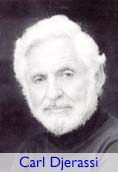Professor Carl Djerassi received his A.B. degree from Kenyon Collage, Ohio in 1944 and obtained a Ph.D. degree in Organic Chemistry from University of Wisconsin, Madison in 1945.
He has been Professor of Chemistry at Stanford University, California since 1959. He was also President of Syntex Research between 1968-72 and Chairman of the Board of Zoecon Corporation between 1968-88.
Professor Djerassi made his initial reputation in the area of steroid synthesis, He made major contributions to methodology and structure determination. His synthesis of the first oral contraceptive pill, norlutin, has been recognised world wide as one of the most significant advances in steroid chemistry.
He established an additional international reputation for his contributions to structure determination using circular dichroism and optical rotary dispersion. His work in this field provides the basis of extensive achievements by himself and others in absolute configuration, relative configurations, and conformational analysis in natural products.
Professor Djerassi, similarly is one of the major figures in the use of mass spectrometry in organic structure datermination. In a monumental series of papers and books he was one of the key figures in the world in making mass spectrometry a regular part of chemistry’s tools.
Professor Djerassi was a key figure in the first (and possibly still the most important) scientific application of artificial intelligence. His work in using computers to utilize spectrocopic date in the DENDRAL series of programs brought computer managed structure determination to life. In the course of this work not only were extraordinary algorithms developed, Djerassi and his students also gathered the critical data necessary for the programs to be succesful. In addition to the areas cited above, he also created a major proton and carbon NMR database.
Professor Djerassi subsequently entered a major new phase with his work on marine chemistry, especially steroids and lipids. His work here, also, has been recognized world wide.
Professor Djerassi has established himself as a major scientific figure in some three or four independent important scientific subjects. Few, if any, chemists have achieved a scientific success of this magnitude.
Professor Djerassi first synthesized and then brought to development the first oral contraceptive. The impact of this work is so well known that it does not require elaboration. It is unquestionably one of the major triumphs of chemistry from a social as well as a financial view point.
Professor Djerassi’s contributions industrially, however, go significantly further than this. He conceived, developed, and was executive of a company devoted to the use of synthetic hormones for past control. Zoecon Corporation was a giant move in the direction of utilizing a totally different kind of chemistry to affect agriculture. It clearly represents the kind of chemistry we will see much more of in the future. Again, Professor Djerassi’s contributions in this regard have been extraordinary and have been recognized by numerous awards and prizes.
In the arena of Public Service, Professor Djerassi stands exceptionally high. For all of his scientific life, he has continually interacted in the areas related to the public interest. First he, has dealt extensively with the social and educational aspects of birth control. Writing, lecturing, and participating in a variety of public forums, he has become a major figure in the issues surrounding birth control and women’s rights.
Professor Djerassi’s development of Zoecon was motivated significantly by his interest in utilizing chemistry most effectively in the area of past control. He recognized some of the problems associated with use of simple chemical pesticides and attempted to deal with their difficulties in a novel and powerful way.
Professor Djerassi has also been active in helping to promote science in developing countries. The insect center in Kenya, scientific programs in Brazil, and arms control issues have all seen him as a central figure. He served on many of the National Academy of Science’s committees designed to deal with these areas.
 |
Professor Carl Djerassi Ph.D.USA
|

